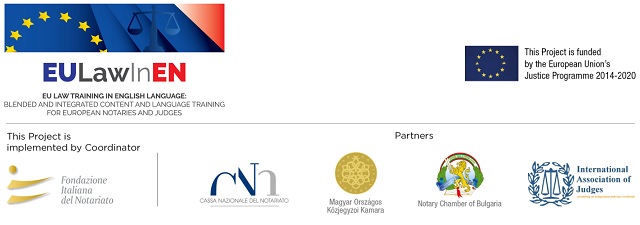Course Overview

The content of the EULAWINEN e-learning products represents the views of the authors only and it is their sole responsibility. The European Commission does not accept any responsibility for use that may be made of the information they contain.
The lesson is dedicated to Comparative law and the EU legal language: a methodology for the national jurist and other international issues and it is part of the e-learning course "e-Regulations in practice" undertaken under the Project "EU law training in English language: blended and integrated content and language training for European notaries and judges" co-financed by the Justice Programme of the European Union. The project is coordinated by the Fondazione Italiana del Notariato in partnership with the Cassa Nazionale del Notariato, the International Association of Judges, the Hungarian Chamber of Civil Law Notaries and the Notary Chamber of Bulgaria.
Please find more information on the Project website at: www.eulawinen.eu
The course deals with cases and issues related to the application of the EU Regulations 650/2012, 1103/2016 and 1104/2016 respectively on successions, matrimonial property regimes and property consequences of registered partnerships.
Each lesson is delivered in English language, following the C.L.I.L. (Content and Language Integrated Learning) didactic methodology adopted in the Project, and is divided into several teaching units that are available on the present MOOC platform.
Access to the final test is possible after having accessed 80% of the entire course, meaning 80% of each lesson.
Learning Objectives
The course aims at contributing to the effective and coherent application of EU civil law by covering training needs gaps, both scientific and linguistic.
Outcomes
The expected results are to reach a greater awareness of the content of the above EU Regulations in English as to replicate the training methodology in other EU countries and contribute to the Regulations uniform application in the Member States.
Course Structure
- Lesson 1 - Comparative law and EU legal language 1
- Lesson 2 - Comparative law and EU legal language 2
- Lesson 3 - Comparative law and EU legal language 3
- Lesson 4 - Comparative law and EU legal language 4
- Lesson 5 - Comparative law and EU legal language 5
- Lesson 6 - Comparative law and EU legal language 6
- Lesson 7 - Comparative law and EU legal language 7
- Lesson 8 - Comparative law and EU legal language 8
- Lesson 9 - Comparative law and EU legal language 9
- Lesson 10 - Comparative law and EU legal language 10
- Lesson 11 - Comparative law and EU legal language 11
- Lesson 12 - Comparative law and EU legal language 12
- Lesson 13 - Comparative law and EU legal language 13
- Lesson 14 - Comparative law and EU legal language 14
Teacher
Elena Ioriatti
Full professor in comparative private law at Trento University Faculty of Law, Italy



